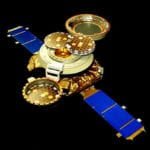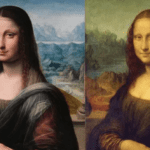 Miscellaneous
Miscellaneous  Miscellaneous
Miscellaneous  Our World
Our World 10 Green Practices That Actually Make a Difference
 Humans
Humans Ten Historic Men Who Deserve Way More Credit Than They Got
 Movies and TV
Movies and TV The 10 Most Heartwarming Moments in Pixar Films
 Travel
Travel Top 10 Religious Architectural Marvels
 Creepy
Creepy 10 Haunted Places in Alabama
 History
History Top 10 Tragic Facts about England’s 9 Days Queen
 Food
Food 10 Weird Foods Inspired by Your Favorite Movies
 Religion
Religion 10 Mind-Blowing Claims and Messages Hidden in the Bible Code
 Facts
Facts 10 Things You Never Knew about the History of Gambling
 Miscellaneous
Miscellaneous Ten Groundbreaking Tattoos with Fascinating Backstories
 Our World
Our World 10 Green Practices That Actually Make a Difference
 Humans
Humans Ten Historic Men Who Deserve Way More Credit Than They Got
Who's Behind Listverse?

Jamie Frater
Head Editor
Jamie founded Listverse due to an insatiable desire to share fascinating, obscure, and bizarre facts. He has been a guest speaker on numerous national radio and television stations and is a five time published author.
More About Us Movies and TV
Movies and TV The 10 Most Heartwarming Moments in Pixar Films
 Travel
Travel Top 10 Religious Architectural Marvels
 Creepy
Creepy 10 Haunted Places in Alabama
 History
History Top 10 Tragic Facts about England’s 9 Days Queen
 Food
Food 10 Weird Foods Inspired by Your Favorite Movies
 Religion
Religion 10 Mind-Blowing Claims and Messages Hidden in the Bible Code
 Facts
Facts 10 Things You Never Knew about the History of Gambling
10 Bizarre Projects That Combine Art And Science
We’ve previously covered how bridging art and science can inspire some weird yet interesting works of art, from clothes made of bacteria to a woman giving birth to a shark. Yet more and more of these bizarre artworks are out there, reminding us that the boundaries between art and science only exist in our minds.
10Paper Sculpture
To maintain their shapes, sculptures are usually carved out of hard materials such as stone, metal, or ceramic. However, Chinese artist Li Hongbo goes for the opposite by building his works out of unconventional material: paper. At first glance, Hongbo’s sculptures look like those made of ceramic or stone. However, when the artist grabs one of them and pulls it apart, it twists, elongates, and retracts as if it were a giant Slinky.
Displayed at the Klein Sun Gallery in New York, the sculptures consist of 7,000–8,000 layered papers placed on top of one another. Hongbo has produced a variety of figures, including the head of Greek goddess Athena and Michelangelo’s David. Regardless of the figures he chooses, Hongbo’s sculptures maintain their hidden element of surprise that is unleashed as they stretch into different shapes.
9The Strandbeest
The wind is a great source of energy that can power homes or destroy them. But to the Dutch artist, Theo Jansen, the wind is more like a soul that brings his kinetic sculptures to life. Since 1990, Jansen has been occupied with creating his most famous works of art: the Strandbeest. By employing both art and engineering, Jansen transforms his Strandbeest (Dutch for “beach beast”) into lifelike creatures that can move on their own and respond to their environment.
A Strandbeest sculpture consists of an intricate assembly of plastic tubes, bottles, and winglike sails. Once the sculpture catches wind, its wings start flapping, driving special pumps that fill the bottles with pressurized air. After the bottles become full, it’s only matter of removing a cap before the air flows out of the bottles at high speed, bringing the sculpture into animal-like motion. Jansen has created various Strandbeest projects in a variety of sizes and shapes. Almost all of them are made of cheap recycled materials that can be found in any dumpster.
8Mushroom Burial Suit
You might think that our generous contributions to polluting our planet end when we die. But unfortunately, that is not the case. Our bodies are, in fact, a temporary storage for a variety of environmental toxins. Most of these toxins remain in our body until we die. Traditional burial methods release these toxins back into the environment. Jae Rhim Lee is a creative bio-artist that came up with a solution to this problem.
Through her Infinity Burial Project, Lee proposed an alternative, environmentally friendly way of treating human bodies after death. The project involves developing a burial suit, which contains a mushroom that accelerates the decomposition of the human body after death. The prototype of the burial suit, which Lee jokingly calls “Ninja pajamas,” is covered with threads of mushroom spores in a pattern similar to that of the dendritic growth of a mycelium. To activate the suit, special makeup is applied to the body, consisting of a mixture of dry mineral makeup and dried mushroom spores. The makeup is necessary to stimulate the growth of the mushroom and accelerate decomposition.
The idea of using our dead bodies as food for mushrooms might not appeal to many people, but Lee has an entirely different perspective. According to her, the death suit will not only reduce our burden on the planet but also help us realize that death is only the beginning of our long-term influence on the environment.
7The Moon House Project
The Moon House Project involves building a Swedish-style red house that will breathe life into the barren landscape of the Moon. The project was initiated by a Swedish artist named Mikael Genberg. Genberg saw the feasibility of the project after he heard that the Swedish Space Corporation was planning to launch a satellite to orbit around the Moon. However, the calculated costs of transporting the house to the Moon came close to $15 million. But to Genberg, there seems to be hope on the horizon. The Internet has created many opportunities for the project to reach people from all over the world. Genberg hopes that with a global crowdfunding of the Moon House, people and not governments will fund a mission to the Moon, for the first time in history.
A house on the Moon is a cool idea, but why does it have to be a Swedish-style home? Well, the project’s crowdfunding is organized by Falu Rodfarg, the manufacturer of the Falu red paint that is used on traditional Swedish houses. Rodfarg honors those who contribute $50 by having their names engraved inside the Moon House.
6The Great Work Of The Metal Lover
Since antiquity, chemists have been pursing the dream of transforming base metals, such as iron and lead, into gold. As far as we know, none of them have ever succeeded. Nevertheless, two researchers from Michigan State University have somehow managed to make that dream a reality.
The researchers, Adam Brown and Kazem Kashefi have combined biotechnology, art, and alchemy to transform soluble gold (gold dissolved in chloroauric acid) into solid 24-karat gold. Their research is based on the fact that a large portion of the Earth’s gold is formed not only through heat, pressure, and geochemical processes but also by microorganisms. Therefore, gold production can be achieved in a lab by gathering these microorganisms in a special bioreactor. By altering the atmosphere within the reactor, the bacteria can be forced to metabolize concentrated amounts of gold chloride, which can then be easily turned into tiny deposits of 99 percent pure gold.
Brown and Kashefi named their artwork The Great Work of the Metal Lover. It consists of special lab equipment that includes a glass bioreactor to contain the bacteria and a gas tank filled with hydrogen and carbon dioxide. The gold-making process is documented by a microscope and a camera that captures close-up pictures of the produced gold.
5Soap Made From Human Fat
If you ever had a liposuction, probably the last thing you’d want to see is the lump of fat that made you look less sexy. You might tell your doctor to throw it away or simply refuse to see it. But that was not the case for Miami-based performance artist Orestes de la Paz. Orestes underwent a liposuction procedure to remove excess fat from his body. Initially, Orestes thought to make the blubber into some kind of acrylic memoir. However, his doctor told him that the only way to keep the blubber was by converting it into something else.
From biology classes he’d taken in college, Orestes remembered that soap was made from fat. That’s when the idea of turning his blubber into soap came to his mind, transforming a dirty and repulsive thing into something that is clean and cleansing. Orestes displayed his work at Miami’s Frost Museum, where attendees came and washed their hands with his “lipo-soap.” Surprisingly, none of the visitors seemed disgusted by the soap, even after watching the video in the gallery of how it was made.
4Rain Room
Imagine if you could walk on the streets on a rainy day without getting a single drop of rain on you. That’s what it feels like when you walk into the Rain Room in The Curve gallery at the Barbican Centre in London. Developed by Random International, the Rain Room consists of a 100-square-meter (1076 ft2) field of falling water, which visitors are invited to walk through. Once the visitors enter the field, the rain stops around them, giving them an experience of how it might feel to control the weather.
The Rain Room is a highly sophisticated integration of art and technology. It is controlled by a number of cameras that map the positions of the visitors on the field. This data is then fed into a grid of square panels, each of which controls several outlets that eject a total of 2,500 liters (660 gal) of falling water. Used water is then filtered, treated, and pumped back into the installation.
3The Treachery Of Sanctuary
The aesthetic value of ordinary paintings or sculptures might not be apparent to everyone. But that is rarely the case with interactive arts that are often captivating even to the least imaginative of us. Speaking of interactive arts, The Treachery of Sanctuary is one that has earned the spotlight in various exhibitions around the world. This interactive installation incorporates three panels that capture, digitally modify, and display the shadow of the person standing in front of it. Created by Chris Milk, the work is intended to share a story of birth, death, and transfiguration in which the viewers can participate by using only the shadows of their own bodies.
Suspended from the ceiling, the installation consists of three 9-meter-high (30 ft) white panels onto which digitally manipulated shadows are projected. The viewer’s shadows and movements are captured using three hidden Kinects. The data is then processed using 3-D software that adds special effects to the shadows. Each one of the three panels is intended to tell a different story. Inside the first panel, the viewer’s body disintegrates into flying birds, representing the moment of birth of both the human and the artistic inspiration. In the second panel, the birds that were meant to represent conception become brutal, attacking the viewer’s figure with their beaks. In the third panel, the viewer’s shadow grows gigantic wings that represent death, the end of the human journey.
2The Poop-Making Machine
Wim Delvoye is a Belgian artist known for his abnormal and often shocking art projects. All of Delvoye’s works have a common theme that associates the attractive with the repulsive. The most famous among them is “Cloaca,” a large digestive machine that turns food into feces. Cloaca consists of an intricate combination of equipment that includes a computer-controlled reactor, an electrical system, pumps, and glass jars containing acids and bacteria. All of these components work together to mimic the human digestive system.
Cloaca was installed in the New Museum of Contemporary Art in SoHo, where Delvoye has demonstrated how it works. First, food is cut into small pieces and thrown into Cloaca’s “mouth.” The machine then washes down the food with a drink served to it (a Belgian beer, on one occasion). Once the meal is over, it proceeds with digesting the food, a process that takes 22 hours. Cloaca then completes its digestion cycle with its prime functionality—defecating. The (repulsive) output is similar to the human equivalent in color, shape, and smell.
1MEART: The Semi-Living Artist
When the word “art” comes to our minds, we tend to associate it with humans only. After all, creativity is what we believe distinguishes us from other beings. However, a project by a research group in Atlanta has proven us wrong. Multi-Electrode Array art, or MEART, brings together engineering, biotechnology, and art to create an artist that is anything but human.
MEART consists of a brain and a body that are geographically detached. The brain, which is located in Atlanta, is made of rat neurons in a culture grown in a lab. The body, on the other hand, is made of robotic arms holding markers and is located in Perth. The brain and body interact through the Internet in a real-time communication loop. Once pieced together, the semi-living artist demonstrates its creativity by drawing on pieces of paper using both his brain and robotic arms. A camera is placed above the workspace to captures the drawing progress. The produced drawings might not look as fancy as the Mona Lisa, but they are, nonetheless, impressive bearing in mind the fact that they were made by a “non-human” art installation.
Follow Hamza Isaac on Facebook.








